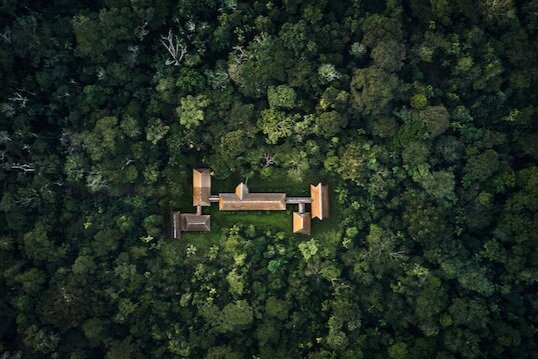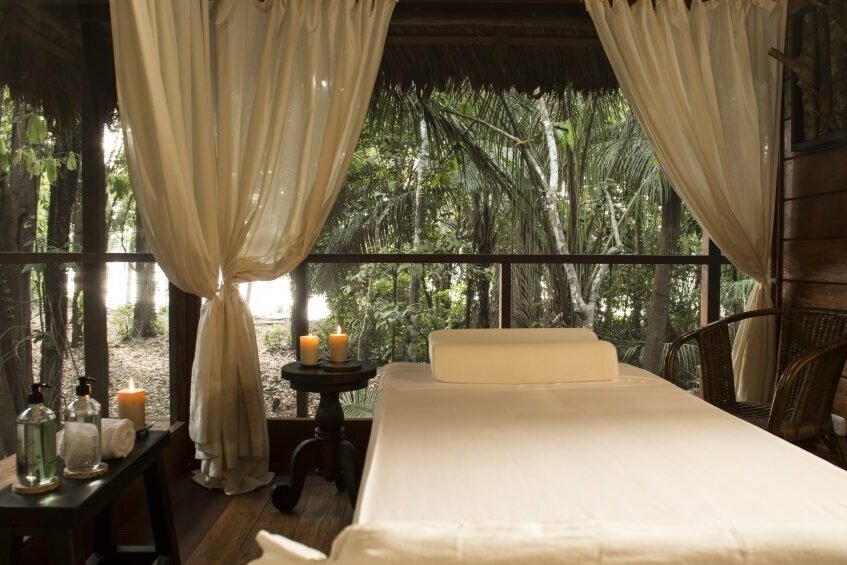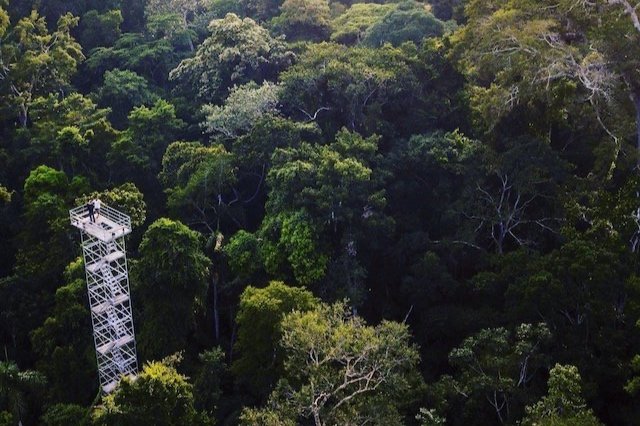Tambopata Amazon Lodge Comparison
Puerto Maldonado is hub for fabulous array of Low Amazon lodge options.
Gateway to spectacular Tambopata & Bahuaja-Sonene National Reserves.
Here’s how to understand the differences - sometimes subtle - within this offering.
What to look for in a lodge & comparison of favourites.
Comparison Table
Tambopata research Center
Daily Rate: from
£271 / $336 pp
Size: 25 rooms
Distance from PEM?
74 km / 55 mi
Upstream
Journey Time: 4hrs
Protected Area? Yes
✘ A/C
✔ Private Bathrooms
✔ Electricity
(not 24/7)
✔ WiFi (slow)
✘ Swimming pool
✘ Canopy Walkway
✘ Zip-Lining
✔ Clay Lick
✘ Jungle Camping
refugio amazonas
Daily Rate: from
£223 / $277 pp
Size: 32 rooms
Distance from PEM?
36 km / 22 mi
Upstream
Journey Time: 2hrs
Protected Area? Yes
✘ A/C
✔ Private Bathrooms
✔ Electricity
(not 24/7)
✔ WiFi (slow)
✘ Swimming pool
✔ Canopy Tower
✘ Zip-Lining
✔ Clay Lick
✘ Jungle Camping
posada amazonas
Daily Rate: from
£223 / $277 pp
Size: 30 rooms
Distance from PEM?
24 km / 15 mi
Upstream
Journey Time: 2hrs
Protected Area? Yes
✘ A/C
✔ Private Bathrooms
✔ Electricity
(not 24/7)
✔ WiFi (slow)
✘ Swimming pool
✔ Canopy Tower
✘ Zip-lining
✔ Clay Lick
✘ Jungle Camping
Sandoval lake lodge
Daily Rate: from
£149 / $185 pp
Size: 25 rooms
Distance from PEM?
20 km / 12 mi
Downstream
Journey Time: 30 mins
Protected Area? Yes
✘ A/C
✔ Private Bathrooms
✔ Electricity
(not 24/7)
✔ WiFi (slow)
✘ Swimming pool
✘ Canopy Walkway
✘ Zip-Lining
✘ Clay Lick
✘ Jungle Camping
reserva amazonica
Daily Rate: from
£142 / $176 pp
Size: 35 bungalows
Distance from PEM?
19 km / 11 mi
Downstream
Journey Time: 1hr
Protected Area? Yes
✘ A/C
✔ Private Bathrooms
✔ Electricity
(not 24/7)
✘ WiFi
✘ Swimming pool
✔ Canopy Walkway
✘ Zip-Lining
✘ Clay Lick
✘ Jungle Camping
ExPLORER’S Inn
Daily Rate: from
£109 / $136 pp
Size: 28 bungalows
Distance from PEM?
26 km / 16 mi
Upstream
Journey Time: 3hrs
Protected Area? Yes
✘ A/C
✔ Private Bathrooms
✔ Electricity
(Solar)
✔ WiFi
(in public areas)
✘ Swimming pool
✔ Canopy Tower
✘ Zip-Lining
✔ Clay Lick
✘ Jungle Camping
Wasai tambopata
Daily Rate: from
£107 / $132 pp
Size: 19 bungalows
Distance from PEM?
43 km / 27 mi
Upstream
Journey Time: 2 hrs
Protected Area? Yes
✘ A/C
✔ Private Bathrooms
✔ Electricity (Solar)
✘ WiFi
✘ Swimming pool
✘ Canopy Walkway
✔ Zip-lining
✔ Kayaking
✔ Clay Lick
✔ Jungle Camping
hacienda concepcion
Daily Rate: from
£101 / $125 pp
Size: 25 bungalows;
5 rooms
Distance from PEM?
15 km / 9 mi
Downstream
Journey Time: 30 mins
Protected Area? Yes
✘ A/C
✔ Private Bathrooms
✔ Electricity
(not 24/7)
✘ WiFi
✘ Swimming pool
✘ Canopy Walkway
✘ Zip-lining
✘ Clay Lick
✘ Jungle Camping
Chuncho
Daily Rate: from
£100 / $124 pp
Size: 10 bungalows
Distance from PEM?
70 km / 43 mi
Upstream
Journey Time: 1.5 hrs
Protected Area? Yes
✘ A/C
✔ Private Bathrooms
✔ Electricity
(not 24/7)
✘ WiFi
✘ Swimming pool
✔ Canopy Tower
✘ Zip-Lining
✔ Clay Licks
✘ Biking
✘ Jungle Camping
For a comparison of the Amazon lodges accessed from Iquitos (Northern Peru), click here.
Criteria
Two-thirds of Peru's territory is classed as Amazon Rainforest, and there are a number of popular entry points. One of those is Puerto Maldonado, in Madre de Dios, which is just a short flight from Cusco.
With so many high-quality Amazon lodges in the area, selecting the one that suits your interests, needs and budget can be tricky. For that reason PeruNorth has created a Tambopata Lodge Comparison chart to help you decide. It is based on a number of criteria:
Location:
Lodges are typically defined by their location. So, the remoter the lodge, the better the chance of seeing rarer species - such as felines - but the more expensive it is, owing to the additional logistical costs.
Lodges located near national parks, such as Tambopata or Bahuaja-Sonene - or within large private reserves - have advantages over lodges located in areas without protection, and/or close to urban areas, in that they will have a higher diversity and density of wildlife.
When choosing a lodge, always investigate the location. We have provided a map to assist you with this, and given you the distance, as the crow flies, from Puerto Maldonado Airport (PEM) … along with the approximate time it takes to get from the airport to the lodge, using both land and river vehicles.
2. Size:
Owing to their location in remote jungle areas, and the need to maintain a low footprint, all Amazon lodges in Peru would be considered ‘small’ by hospitality standards. Nonetheless, there is obviously a difference between a lodge with 6 rooms as opposed to 30.
In the former, if you have a gregarious nature, it is easy to get to know all the other guests and many of the staff.
Conversely, there is only a small cross-section of people to spend time with, especially if the lodge is not full, and you may not appreciate being thrown together with travellers with whom you have little in common.
Also, at a smaller lodge, there may not be enough English-speaking visitors to merit a dedicated English-speaking guide, so you may find the guide’s descriptions being delivered in Spanish and English, which can be a little frustrating.
At a larger lodge, there is inevitably a little more anonymity, but the chances of finding kindred spirits amongst the other guests is improved.
3. Amenities:
Staying in a lodge, surrounded by Amazon jungle, puts visitors in close contact with the natural environment. You feel the presence of the eco-system all around you; and at night, you hear the sounds of the nocturnal rainforest world. An Amazon lodge stay lets you feel part of the natural cycle of sleeping at dusk and rising at dawn.
But, you can choose how ‘close-to-nature’ an experience you want. There are some lodges where the accommodation is similar to a hotel room, with air-conditioning, 24-hour electricity and hot water, and a housekeeping service.
Moreover, a number of Amazon lodges have a swimming pool, which may be of particular interest to those travelling with children.
At the other end of the spectrum, there are more rustic lodges whose rooms are in wooden cabins, with mosquito nets for windows, a bed or beds, ceiling fan and lighting provided by candles or lanterns.
So, it is important to consider which creature comforts you can and cannot live without when choosing a lodge.
4. Guiding:
In an area of enormous biodiversity, such as the Amazon Rainforest, a good naturalist guide, with the knowledge, enthusiasm and language skills to bring the flora and fauna to life, is vital.
While it is not possible to know the relative merits of all the many guides working in the Amazon, there are lodges that are known to invest more in training their staff. These tend to be at the upper end of the price scale.
5. ACTIVITIES:
It is true to say that there are excursions that are common to most Amazon lodges:
Boat safaris to view fauna, especially birdlife.
Nature hikes along designated trails, to examine rainforest flora & insect life.
Fishing for piranha - & other small fish species - using rudimentary hand-made equipment.
Visits to riverside villages - with perhaps a stop at the local school - to witness daily Amazonian existence.
Night-time walks around the lodge, looking - and listening - for nocturnal bats, birds, amphibians & arachnids.
However, there are activities that are peculiar to one, or a few, lodges. This is often dependant on their location.
Canopy Towers / Walkways: with over 50% of the Amazon Rainforest’s biodiversity to be found in the foliage at the tops of the trees, it is well worth getting aerial to witness this facet of the jungle.
In order to do this, various lodges have constructed towers and/or bridges strung between the trees, offering wonderful views and bird-spotting opportunities. A couple of lodges have gone one further, by offering the chance to sleep in a treehouse.Clay Licks (kollpas): the banks of certain Amazonian rivers - especially in the Tambopata region - attract various bird and mammal species, whom it is believed eat the clay in order to benefit from the minerals contained within.
If you want to see macaws, parrots and parakeets in their hundreds, a tapir, or a herd of peccaries, a kollpa is a must. Many lodges have constructed blinds in order to best view the animals, without disturbing them.Oxbow Lakes: often the home of Giant River Otters, and generally abundant with wildlife.
Adventure activities:
Camping: a number of lodges offer a night under canvas in the jungle as part of longer itineraries. This is a great way to experience the Amazon at its rawest, immersed in the sights, sounds and smells. Not for the faint-hearted, although the guides set up the tents, cook the meals and are present throughout.
Kayaking: gentle paddling on a serene Amazonian lake is a wonderful format for enjoying the flora and fauna. Unhurried and quiet.
Zip-lining
Mountain-biking
Raft-building
Yoga: many people say that the Amazon Rainforest has a unique energy, deriving from the sheer number of trees and the oxygen they create.
Lodges often have a communal space (maloka) that is ideal for yoga classes. However, they seldom provide an instructor; instead, yoga specialists book a lodge (or part of it) for certain dates of the year, with an invited guru to lead the classes. Yogi can then join these groups.
6. Price:
Obviously budget is important, so we have provided a daily rate for each lodge, in GBP and USD, for comparison purposes. This is based on two people sharing a room during a 4-day lodge stay, which includes transport, meals, excursions and English-speaking guides.
Flights are not included in lodge rates, but you can get a quote here.
NB. Costs and exchange rates do fluctuate, so prices given in the table are meant as a guideline only.










